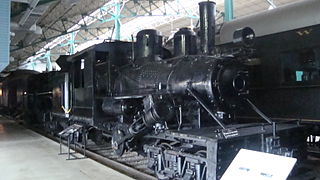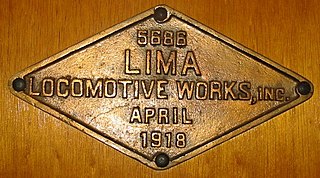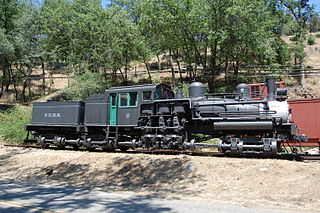
A geared steam locomotive is a type of steam locomotive which uses gearing, usually reduction gearing, in the drivetrain, as opposed to the common directly driven design.

The Shay locomotive is a geared steam locomotive that originated and was primarily used in North America. The locomotives were built to the patents of Ephraim Shay, who has been credited with the popularization of the concept of a geared steam locomotive. Although the design of Ephraim Shay's early locomotives differed from later ones, there is a clear line of development that joins all Shays. Shay locomotives were especially suited to logging, mining and industrial operations and could operate successfully on steep or poor quality track.

A Climax locomotive is a type of geared steam locomotive built by the Climax Manufacturing Company, of Corry, Pennsylvania. These had two steam cylinders attached to a transmission located under the center of the boiler, which sent power to driveshafts running to the front and rear trucks. Some 1,000-1,100 were built in three classes between 1888 and 1928.

The Willamette locomotive was a geared steam locomotive of the Shay locomotive type, built by the Willamette Iron and Steel Works of Portland, Oregon. After key patents on the Shay locomotive had expired, it was possible for other manufacturers to produce Shay-like locomotive designs.

The Jamison Valley forms part of the Coxs River canyon system in the Blue Mountains of New South Wales, Australia. It is situated approximately 100 kilometres west of Sydney, capital of New South Wales, and a few kilometres south of Katoomba, the main town in the Blue Mountains.

Lima Locomotive Works (LLW) was an American firm that manufactured railroad locomotives from the 1870s through the 1950s. The company's name is derived from the location of its main manufacturing plant in Lima, Ohio. The shops were located between the Erie Railroad main line, the Baltimore & Ohio's Cincinnati-Toledo main line and the Nickel Plate Road main line and shops.

The Narrow Neck Plateau is an eroded remnant of a sandstone layer situated at an elevation of 1,000 metres (3,300 ft) above sea level and part of the Blue Mountains, a spur line of the Great Dividing Range immediately southwest of Katoomba in New South Wales, Australia, within the Blue Mountains National Park. The neck separates the Jamison Valley to the east from the Megalong Valley to the west.

Cass Scenic Railroad State Park is a state park and heritage railroad located in Cass, Pocahontas County, West Virginia.

The Yosemite Mountain Sugar Pine Railroad (YMSPRR) is a historic 3 ft narrow gauge railway with two operating steam locomotives located near Fish Camp, California, in the Sierra National Forest near the southern entrance to Yosemite National Park. Rudy Stauffer organized the YMSPRR in 1961, utilizing historic railroad track, rolling stock and locomotives to construct a tourist line along the historic route of the Madera Sugar Pine Lumber Company.

The Alberni Pacific Railway is a heritage railway originating in Port Alberni, British Columbia. The Alberni Pacific Railway returned to operations along the Port Alberni Waterfront in Summer of 2024, and is expected to run until the end of September. The Santa Train will also return in 2024 along with other popular events. www.albernipacificrailway.ca is where you can find out about the 2024 Operations.

The Kettle Valley Steam Railway is a heritage railway near Summerland, British Columbia.

The BC Forest Discovery Centre, located in Duncan, chronicles the history of logging in British Columbia, Canada. It is a 100-acre (40 ha) site with 2.5 km of operational 3 ft narrow gauge railway.

Wolgan Valley is a small valley located along the Wolgan River in the Lithgow Region of New South Wales, Australia. The valley is located approximately 32 kilometres (20 mi) north of Lithgow and 150 kilometres north-west of Sydney. Accessible by the Wolgan Valley Discovery Trail from the Castlereagh Highway, the road travels through the valley leading onto the historical village of Newnes and its extensive industrial ruins.

The Laurel Fork Railway was a small, standard-gauge logging railroad that operated entirely in Carter County, Tennessee from 1912 to 1927. Built by the Pittsburgh Lumber Company to serve a double-band sawmill at Braemar, in present-day Hampton, Tennessee.
The Lenora Mt. Sicker Railway was a narrow-gauge railway which hauled copper ore from the Lenora mine on Mount Sicker to tidewater at Crofton on southern Vancouver Island, British Columbia.

The Newnes railway line is a closed and dismantled railway line in New South Wales, Australia. The line ran for 32 mi (51 km) from the Main Western line to the township of Newnes. Along the way, it passed through a tunnel now known as the Glowworm Tunnel, because it is famous for its glow-worms. The tunnel is now contained within the Wollemi National Park.

The Powelltown tramway was a 3 ft narrow gauge tramway that operated between Powelltown and Yarra Junction, Victoria, Australia, between 1913 and 1945.

Hetch Hetchy Railroad no. 6 is a standard gauge three truck Shay locomotive built for the Hetch Hetchy Railroad by Lima Locomotive Works in 1921.

Metropolitan is an unincorporated community in Humboldt County, California. It is located on McDairmid Prairie, on the north side of the Eel River floodplain three miles downstream of Scotia, at an elevation of 72 feet.

The Winterthur–Romanshorn railway, also known in German as the Thurtallinie, is a Swiss railway line and was built as part of the railway between Zürich and Lake Constance (Bodensee). It connects Winterthur with Romanshorn, where it formerly connected to train ferries over Lake Constance. It is the fourth oldest internal railway in Switzerland. Its construction was to be funded by the Zürich-Lake Constance Railway (Zürich-Bodenseebahn), but during the construction the company was merged with the Swiss Northern Railway to form the Swiss Northeastern Railway. The Winterthur–Romanshorn railway was opened on 16 May 1855 and the line from Winterthur to Oerlikon was opened on 27 December 1855. Zürich was reached on 26 June 1856 and the two existing NOB lines were connected.

















